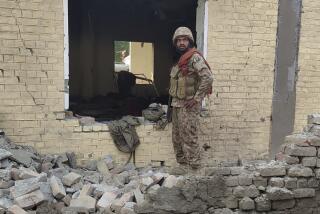A suicide bomber kills as many as 24 in Baghdad
- Share via
BAGHDAD — A minibus laden with explosives blew up in a Shiite Muslim neighborhood in west Baghdad on Saturday, killing as many as 24 people and wounding 46 less than a week before the Iraqi government is scheduled to assume responsibility for its security from the United States.
The attack in the Kadhimiya neighborhood, near a popular flea market and bus stop, underscored Iraq’s continued instability, after days of relative calm.
Despite a significant decline in violence in Baghdad, the threat of random attacks remains. On Tuesday, U.S. Army Gen. Ray Odierno, the senior American commander in Iraq, warned that armed groups such as Al Qaeda in Iraq are still a threat.
Police said they suspected that a suicide attacker drove the empty bus into the crowded square, then detonated the explosives.
A couple of hours later, city workers were busy clearing the scene, heaping debris, burned clothes and the remnants of vendors booths into the back of a GMC truck. All that remained of the minibus was a mangled pile of metal. Broken glass, bits of tire rubber and stray shoes covered the street.
A university professor stood in front of his house nearby, the windows shattered and a piece of car wreckage on the roof.
“When the explosion took place, I hurried up out of the house,” said the professor, who identified himself as Qusai, 27. “I saw more than 20 dead bodies. There were women and children between them. . . . I don’t know who did it, but the goal is to create chaos.”
Vendor Jameel Athab, 37, said he had just left his stall to pray when he heard the explosion and saw the smoke. The bodies, he said, were badly charred, and police carried out the dead and injured in handcarts.
“I don’t know why such attacks take place,” Athab said. “Why do they want to hurt the innocent Iraqi people? What is the goal? If they want to spoil the election, such attacks will not stop [it].”
Provincial elections are scheduled for Jan. 31, and some authorities have warned of a possible uptick in violence. Overall, though, the number of high-profile attacks is down and many Baghdad residents have returned to more normal routines. Businesses are reopening, restaurants are staying open past dark and more people are out and about.
A year-end study released Saturday by Iraq Body Count, which tracks violent civilian deaths, says that about 9,000 civilians were killed this year -- about 25 civilians per day on average -- or about the same number as in 2003 and 2004, after the U.S.-led invasion of Iraq. That is a substantial drop from 2006, when the average was 76 deaths a day, and 2007, with 67 a day.
Also Saturday, authorities in Ramadi, the capital of Anbar province, reported that they had tracked down and killed a suspected Sunni Arab insurgent who helped plot a jailbreak Friday that left six police officers and seven detainees dead.
Police described the escapee, Imad Ahmed Farhan, as a mastermind and leader in the group Al Qaeda in Iraq.
“He held a family hostage, and we were able to free the family,” Anbar province Police Chief Tareq Yusuf Dulaimi said. “The police shot him dead without harming any of the family members.”
Two men suspected of aiding Farhan were arrested, but two escapees are still being sought, the chief said. “We are going to get them very soon,” he added.
The detainees escaped early Friday after one suspect claimed that he was sick and persuaded a prison guard to open the cell. When he opened the door, the detainee wrestled away the guard’s AK-47 assault rifle and killed him, setting off a deadly riot.
--
Times staff writers Ned Parker and Saif Hameed and a special correspondent in Ramadi contributed to this report.
More to Read
Sign up for Essential California
The most important California stories and recommendations in your inbox every morning.
You may occasionally receive promotional content from the Los Angeles Times.














